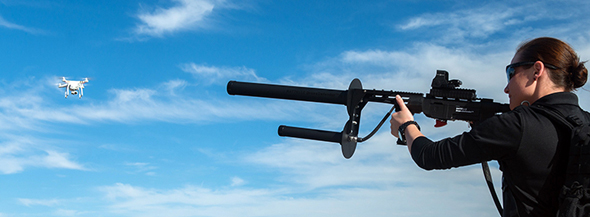INDIAN ARMED FORCES CHIEFS ON
OUR RELENTLESS AND FOCUSED PUBLISHING EFFORTS

SP Guide Publications puts forth a well compiled articulation of issues, pursuits and accomplishments of the Indian Army, over the years

I am confident that SP Guide Publications would continue to inform, inspire and influence.

My compliments to SP Guide Publications for informative and credible reportage on contemporary aerospace issues over the past six decades.
- Interim Defence Budget 2024-25 — An Analysis
- Union Defence budget 2024
- Indian Army: In quest of greater firepower and policy recommendations for gaps
- Indian Army Annual Press Conference 2024
- 6G will transform military-industrial applications
- Tata Boeing Aerospace Delivers 250 AH-64 Apache Fuselages, Manufactured in India
Coping with Drone Terror
 |
By Lt. General P.C. Katoch (Retd) Former Director General of Information Systems, Indian Army |
With two Interpol red corner notices ticked under his belt and well protected in Pakistan despite being the mastermind of the 26/11 Mumbai terrorist attacks, JuD chief Hafiz Saeed recently threatened, "If any drone attack takes place against Pakistan from Indian bases, we have enough drones for whole India", reiterating the threat to nuke India. Of course he is the unofficial mouthpiece of Pakistan's ISI and makes such periodic statements for remaining in the limelight much like Paervez Musharraf. But the fact is that drone terrorism is more than a reality especially through Pakistan sponsored terror organizations. As far back as 1995 the Aum Shinrikyo cult that undertook multiple Sarin Gas attacks on the Tokyo subway was later found to be having enough Sarin to kill one million Tokyoites and had planned to use two remote controlled helicopters to spray the gas, but both unfortunately crashed during trials.
This is the reason why other than declaring no fly zones over the 10 stadiums in France hosting Euro 2016 from June 10 to July 10, anti-drone technology has been employed to cope with the terror threat in the backdrop of enhanced terror warnings post the November 2015 Paris attacks, in which 130 people were killed. French authorities have readied for the possibility of terrorists using drones to disperse chemical or biological weapons over crowds. Proliferation of drones is accelerating at rapid rate with revenues from commercial drones alone estimated to top $12 billion by 2021, up from just over $8 billion in 2015. In addition, the market of military drones in estimated to exceed 410 billion by mid 2020s. Little wonder then that that anti-drone technologies, solutions and anti-drone guns are being developed. Solutions like DroneShield, MalDrone, Pwnie Express, DeTect and the like have already emerged. The Pentagon is reportedly acquiring some 100 DroneDefender Systems to cope with the threat of terrorists using drones deliver bombs, spying, narcotics delivery and the like. Though the system looks like a gun (picture below) it actually is a gun shaped radio whose signal with a range of 400 metres can interrupt either the control frequencies of a drone or its access to GPS coordinates.

DroneDefender
The Subcontinent too is set to witness rapid proliferation of drones well, especially with China's mass production base in both commercial and military category of drones, already being exported including to Pakistan. The recent claim by Pakistan it had shot down an Indian drone which eventually turned out to be Chinese, proves it. China has recently developed a passenger drone as well that provides far greater carriage capacity for terrorist acts. India itself is home to large number of drones. As per SIPRI, 1,574 drone transfers (including 16 armed drones) took place across the world between 1985 and 2014; India was the top drone importer after UK and France, with 22.5% share. Then we have multiple manufactures in India marketing drones as remote controlled toys for children, cam-copters for surveillance and private clubs indulging in drone flying adventure. Drones are being used in the country for shooting concerts and movies, filming private parties, by police organizations for surveillance and monitoring traffic, and for surveillance and intelligence gathering by armed forces. The NDRF used drones during the earthquake relief in Nepal. Significantly, the DGCA had announced in October 2014 that till proper rules and regulations are formulated, use of drones in the country is "illegal".
Significantly, while Amazon has successfully conducted test bed for delivery of items at the customer's doorsteps, it cannot make it operational in the US unless the regulations for use of drones are revamped and promulgated. This is what needs to be enforced in India. Monitoring such equipment in a populous country like ours is a herculean task, and yet it must be done. It amounts to tracking the manufactured equipment, its sale and locations by incorporating the population into reporting possible misuse. Compared to larger UAVs, small drones are much more difficult to detect as they need little space to take off. Over and above detection, is the problem of intercepting and bringing down a terror drones without activation their lethal loads. It may be recalled that in December 2011, Iran captured intact a top of the line American Lockheed Martin RQ-170 Sentinel stealth UAV; claiming it was brought down by their cyber-warfare unit, commandeering it in flight and safely landing it albeit western sources claimed it was shot down. Terrorists, especially the state sponsored ones, are looking at new methods assisted by technology to strike us. We need adequate focus on drone terrorism. Our DRDO and private industry need to work double time on such issues. Optimizing on our strategic and defence relationships, our 'Make in India' initiative must give priority to speedily develop and deploy anti-drone solutions.
Photo Credit: www.battelle.org





